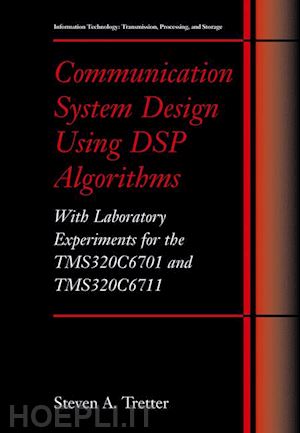
Questo prodotto usufruisce delle SPEDIZIONI GRATIS
selezionando l'opzione Corriere Veloce in fase di ordine.
Pagabile anche con Carta della cultura giovani e del merito, 18App Bonus Cultura e Carta del Docente
Designed for senior electrical engineering students, this textbook explores the theoretical concepts of digital signal processing and communication systems by presenting laboratory experiments using real-time DSP hardware. The experiments are designed for the Texas Instruments TMS320C6701 Evaluation Module or TMS320C6711 DSK but can easily be adapted to other DSP boards. Each chapter begins with a presentation of the required theory and concludes with instructions for performing experiments to implement the theory. In the process of performing the experiments, students gain experience in working with software tools and equipment commonly used in industry.
The primary focus of this book is on communication systems. Algorithms that are particularly suited to DSP implementations are presented. Chapters 1 and 2 introduce the software and hardware tools. Chapter 3 presents FIR and IIR digital filters and Chapter 4 investigates the FFT. Chapters 4 through 8 discuss modulators and demodulators for classical analog modulation methods such as amplitude modulation (AM), double-sideband suppressed-carrier amplitude modulation (DSBSC-AM), single sideband modulation (SSB), and frequency modulation (FM). Chapters 9 through 16 explore digital communication methods leading to the implementation of a complete telephone-line modem. These chapters include shift register pseudo-random binary sequence generators, the RS-232 protocol, pulse amplitude modulation (PAM), quadrature amplitude modulation (QAM) transmitters and receivers, and echo cancellation. Methods for adaptive equalization, carrier recovery, and symbol clock tracking are presented. Chapter 17 gives suggestions for additional experiments.











Il sito utilizza cookie ed altri strumenti di tracciamento che raccolgono informazioni dal dispositivo dell’utente. Oltre ai cookie tecnici ed analitici aggregati, strettamente necessari per il funzionamento di questo sito web, previo consenso dell’utente possono essere installati cookie di profilazione e marketing e cookie dei social media. Cliccando su “Accetto tutti i cookie” saranno attivate tutte le categorie di cookie. Per accettare solo deterninate categorie di cookie, cliccare invece su “Impostazioni cookie”. Chiudendo il banner o continuando a navigare saranno installati solo cookie tecnici. Per maggiori dettagli, consultare la Cookie Policy.